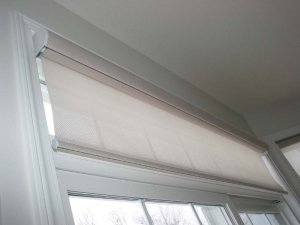window shades

When properly installed, window shades can be one of the simplest and most effective window treatments for saving energy.
Shades should be mounted as close to the glass as possible with the sides of the shade held close to the wall to establish a sealed air space. You should lower shades on sunlit windows in the summer. Shades on the south side of a house should be raised in the winter during the day, then lowered during the night.
For greater efficiency, use dual shades – highly reflective (white) on one side and heat absorbing (dark) on the other side – that can be reversed with the seasons. The reflective side should always face the warmest side: outward during the cooling season and inward during the heating season. They need to be drawn all day to be effective.
Quilted roller shades, and some types of Roman shades, feature several layers of fiber batting and sealed edges. These shades act as both insulation and air barrier. They control air infiltration more effectively than other soft window treatments.
Pleated or cellular shades
Several manufacturers have designed two- or three-cell pleated or cellular shades with dead air spaces, which increase their insulating value. These shades, however, provide only slight control of air infiltration.
See all window coverings and treatments.
